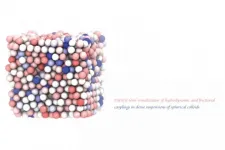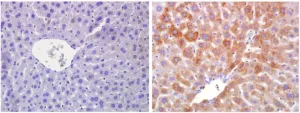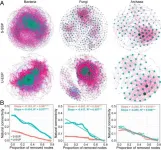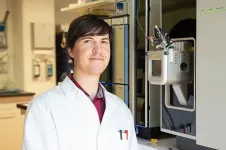(Press-News.org) Tokyo, Japan - Colloids--mixtures of particles made from one substance, dispersed in another substance--crop up in numerous areas of everyday life, including cosmetics, food and dyes, and form important systems within our bodies. Understanding the behavior of colloids therefore has wide-ranging implications, yet investigating the rotation of spherical particles has been challenging. Now, an international team including researchers from The University of Tokyo Institute of Industrial Science has created particles with an off-center core or "eye" that can be tracked using microscopy. Their findings are published in Physical Review X.
Particles suspended in a liquid move from one place to another as a result of Brownian motion, which can be easily detected with a microscope. However, these particles also rotate, which is much more difficult to see if they are spherical.
The researchers overcame this by creating particles made from two different colors of the same material. The core sphere--which they call the eye--is set off-center at the surface of the particle. It provides a point that can be followed under a microscope to determine the orientation changes as the particle rotates.
"The rotation of a colloidal particle tells us about the surrounding hydrodynamics--the motion of the suspending liquid--and the contact forces, such as friction. However, to get the full picture in a dense suspension, all of the particles must be tracked at once," explains study corresponding author Professor Hajime Tanaka. "As well as providing a point to track over time, the density and refractive index of our particles can be matched so that the necessary 3D images can be acquired."
By tracking a dense suspension of charged particles forming a colloidal crystal--which has an ordered arrangement of particles--it was found that the rotation of neighboring spheres was coupled and moved in opposite directions, like meshed gears.
In addition, a system with uncharged particles showed that there was a relationship between local crystallinity--the ordering in the immediate surroundings--and the rotational diffusivity, which describes the process of the orientation regaining equilibrium.
The researchers also observed "stick-slip" rotational motion between particles that make contact, where a large neighbor could stop the motion of a particle through friction.
"Our system has provided much-needed insight into hydrodynamic and frictional coupling in very dense colloids," says other corresponding author Professor Roel Dullens. "We expect our findings to have a significant impact on the design of industrial processes involving colloids, as well as on the understanding of biological processes."
INFORMATION:
The article, "Particle-level visualization of hydrodynamic and frictional couplings in dense suspensions of spherical colloids", was published in Physical Review X at DOI: 10.1103/PhysRevX.11.021056.
About Institute of Industrial Science (IIS), the University of Tokyo
Institute of Industrial Science (IIS), the University of Tokyo is one of the largest university-attached research institutes in Japan.
More than 120 research laboratories, each headed by a faculty member, comprise IIS, with more than 1,000 members including approximately 300 staff and 700 students actively engaged in education and research. Our activities cover almost all the areas of engineering disciplines. Since its foundation in 1949, IIS has worked to bridge the huge gaps that exist between academic disciplines and realworld applications.
Getting energy and nutrients from the environment - that is, eating - is such an important function that it has been regulated through sophisticated mechanisms over hundreds of millions of years. Some of these mechanisms are only now beginning to be unravelled. A group at the Spanish National Cancer Research Centre (CNIO) has found one of their key components - a switch that controls the ability of organisms to adapt to low cellular nutrient levels.
The protein involved is RagA, which is part of the mTOR molecular pathway, whose importance in metabolic activity regulation has been known for decades now. CNIO researchers have found that if RagA is continuously activated, cells do not know that there are no sufficient nutrients and so ...
The encryption algorithm GEA-1 was implemented in mobile phones in the 1990s to encrypt data connections. Since then, it has been kept secret. Now, a research team from Ruhr-Universität Bochum (RUB), together with colleagues from France and Norway, has analysed the algorithm and has come to the following conclusion: GEA-1 is so easy to break that it must be a deliberately weak encryption that was built in as a backdoor. Although the vulnerability is still present in many modern mobile phones, it no longer poses any significant threat to users, according to the researchers.
Backdoors not useful according to researchers
"Even though intelligence services and ministers of the interior understandably want such backdoors ...
ENVIRONMENT Diesel-polluted soil from now defunct military outposts in Greenland can be remediated using naturally occurring soil bacteria according to an extensive five-year experiment in Mestersvig, East Greenland, to which the University of Copenhagen has contributed.
Mothballed military outposts and stacks of rusting oil drums aren't an unusual sight in Greenland. Indeed, there are about 30 abandoned military installations in Greenland where diesel, once used to keep generators and other machinery running, may have seeped into the ground.
This is the case with Station 9117 Mestersvig, an abandoned military airfield ...
These findings were published in the journal Cellular and Molecular Life Sciences on 8 June 2021.
Huge splicing diversity in the brain
The human genome was sequenced around 20 years ago. Since then, the sequence information encoding our proteins is known - at least in principle. However, this information is not continuously stored in the individual genes, but is divided into smaller coding sections. These coding sections, also known as exons, are assembled in a process called splicing. Depending on the gene, different exon combinations are possible, which is why they are referred to as different or ...
With increasing vaccination rates and decreasing numbers of infections, the population's feeling of safety is also rising. As the results of the 37th edition of the BfR-Corona-Monitor, a regular survey conducted by the German Federal Institute for Risk Assessment (BfR), show, the majority of the population in Germany thinks it can control its risk of an infection well. "62 percent are confident that they can protect themselves from an infection with the coronavirus," says BfR-President Professor Dr. Dr. Andreas Hensel. "We see that the feeling of safety has increased considerably. ...
Chinese researchers have recently discovered links between reduction in microbial stability and soil carbon loss in the active layer of degraded alpine permafrost on the Qinghai-Tibet Plateau (QTP).
The researchers, headed by Prof. CHEN Shengyun from the Northwest Institute of Eco-Environment and Resources (NIEER) of the Chinese Academy of Sciences (CAS), and XUE Kai from University of Chinese Academy of Sciences, conducted a combined in-depth analysis of soil microbial communities and their co-occurrence networks in the active permafrost layer along an extensive gradient of permafrost degradation.
The QTP encompasses the largest extent of high-altitude mountain ...
Greater Helsinki -- Transitioning to low-carbon energy production is the biggest climate challenge to overcome. Many countries are already looking to adopt clean heating solutions more widely, with the International Energy Agency projecting that by 2045 nearly half of global heating will be done with heat pumps. To ensure speedy uptake, governments are likely to offer subsidies to ensure these energy-efficient options actually make their way into homes and offices.
A new study from Aalto University assesses the impact of heat pumps on energy consumption as well as how ...
Research published in the journal ACS Materials and Interfaces has provided new understanding of how false-negative results in Lateral Flow Tests occur and provides opportunity for simple improvements to be made.
Lateral Flow Devices were introduced late in 2020 on a global scale to help detect novel coronavirus infection in individuals, with test results produced rapidly in half an hour or less. However, their potential has been somewhat hindered by inadequate sensitivity, with a high number of false-negative results.
Using X-ray fluorescence imaging from Diamond Light Source, researchers from King's College London ...
Researchers from the University of Kent's School of Psychology have found that when people are presented with the idea of a Covid-19 "immunity passport", they show less willingness to follow social distancing and face covering guidelines. However, this willingness seems to return when people read more cautious information about Covid-19 immunity.
PhD students Ricky Green and Mikey Biddlestone and Professor Karen Douglas asked participants from the UK and USA to imagine they had either recovered from Covid-19 or were currently infected. Participants asked to imagine ...
Several different causes of ageing have been discovered, but the question remains whether there are common underlying mechanisms that determine ageing and lifespan. Researchers from the Max Planck Institute for Biology of Ageing and the CECAD Cluster of Excellence in Ageing research at the University Cologne have now come across folate metabolism in their search for such basic mechanisms. Its regulation underlies many known ageing signalling pathways and leads to longevity. This may provide a new possibility to broadly improve human health during ageing.
In recent decades, ...





